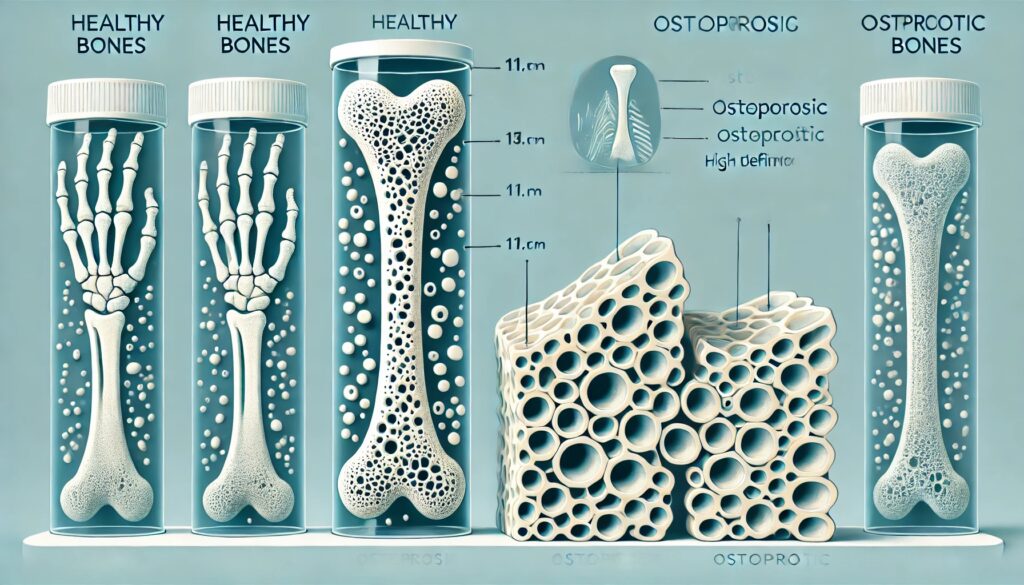
Catch Osteoporosis Early with AI: A Game-Changer in Healthcare
Osteoporosis, a condition characterized by weakened bones and an increased risk of fractures, affects millions worldwide. Artificial Intelligence (AI) is transforming the way we diagnose and treat this condition, offering new hope for patients. From early detection to personalized treatment plans, AI’s role in osteoporosis management is expanding rapidly. Let’s explore how AI is revolutionizing this field.
Early Detection and Risk Prediction
AI-enabled Imaging Techniques
AI-enabled chest X-rays and CT scans are now being used to classify osteoporosis and predict fracture risks. These technologies can identify signs of osteoporosis earlier and with greater accuracy compared to traditional methods. Deep learning algorithms analyze chest X-ray features to classify osteoporosis and assess mortality risks associated with the condition.
Opportunistic Screening
CT scans taken for other purposes are now repurposed to screen for osteoporosis, reducing the need for additional radiation exposure. AI models can predict bone mineral density (BMD) from these scans, facilitating early detection and management.
The synergy of AI and medical research in osteoporosis is a testament to the incredible advancements we can achieve in healthcare.
— Dr. James Lee, AI Research Scientist
Personalized Treatment Plans
Predicting Treatment Responses
AI algorithms analyze large datasets from electronic medical records to predict individual responses to osteoporosis treatments. By considering a patient’s unique medical history and characteristics, these algorithms recommend personalized treatment plans.
Discovering New Treatments
AI is also instrumental in identifying potential new treatments. For instance, AI discovered that dihydroartemisinin, an antimalarial drug, could be used to improve bone density in preclinical models.
Clinical Decision Support
Enhanced Decision-Making
AI tools assist clinicians in making more informed decisions regarding osteoporosis management. These tools analyze a vast array of data, including BMD results, medical histories, and medication profiles, to suggest the most effective treatment strategies. This helps close the treatment gap for patients at high risk of fractures, ensuring they receive timely and appropriate care.

Advancements in Research
Continuous Improvement
Ongoing advancements in AI are enhancing our understanding of osteoporosis. Studies presented at major conferences, such as the World Congress on Osteoporosis, demonstrate the potential of AI in improving clinical outcomes and optimizing treatment protocols based on real-world data.
Cutting-Edge Developments
Deep Learning Models
Researchers at Tulane University have developed a deep learning algorithm that significantly outperforms existing methods for predicting osteoporosis risk. This model, tested on data from over 8,000 participants, has shown superior accuracy in identifying true positives and reducing false negatives. Key risk factors identified include weight, age, gender, and lifestyle habits like smoking and alcohol consumption.
Hormonal Insights
Researchers at the University of Hong Kong discovered the hormone secretin‘s role in regulating bone density through the brain’s ventromedial hypothalamus. This finding opens new avenues for treating both obesity and osteoporosis by targeting brain pathways.
Genetic and Cellular Mechanisms
Genetic Discoveries
A team from Osaka University identified a gene, Men1, linked to osteoporosis through its role in cellular senescence and bone formation. This research offers potential new targets for therapeutic interventions and highlights the complex interplay between genetic factors and bone health.
Promising Drug Targets
Researchers from Tokyo University of Science have identified Gprc5a as a promising drug target, demonstrating its role in regulating osteoblast proliferation and differentiation, crucial for maintaining healthy bone density.
Conclusion
The integration of AI into osteoporosis research and clinical practice is leading to significant advancements in early detection, personalized treatment, and understanding of the disease’s underlying mechanisms. As AI continues to evolve, it holds the promise of better patient outcomes and more efficient healthcare solutions.
FAQ: AI in Osteoporosis Management
Q1: How does AI improve the early detection of osteoporosis?
AI improves early detection by analyzing chest X-rays and CT scans with greater accuracy than traditional methods. Deep learning algorithms can classify osteoporosis and predict fracture risks by identifying signs earlier.
Q2: What role does AI play in personalized treatment for osteoporosis?
AI analyzes large datasets from electronic medical records to predict individual responses to treatments. This helps in recommending personalized treatment plans based on a patient’s unique medical history and characteristics.
Q3: Can AI help in discovering new treatments for osteoporosis?
Yes, AI has identified potential new treatments, such as the antimalarial drug dihydroartemisinin, which can improve bone density. AI aids in drug discovery by analyzing complex data.
Q4: How does AI assist clinicians in managing osteoporosis?
AI tools help clinicians make informed decisions by analyzing data like BMD results, medical histories, and medication profiles. This ensures timely and appropriate care for patients at high risk of fractures.
Q5: What advancements have been made in AI research for osteoporosis?
Recent advancements include the development of deep learning algorithms that outperform existing methods in predicting osteoporosis risk. Studies also explore AI’s role in identifying genetic factors and new drug targets.
Q6: How does AI-enabled opportunistic screening work?
AI can repurpose CT scans taken for other medical reasons to screen for osteoporosis without additional radiation exposure. AI models predict bone mineral density (BMD) from these scans, aiding in early detection.
Q7: What genetic insights have AI studies uncovered related to osteoporosis?
AI research has identified genes like Men1 and Gprc5a, which play roles in bone formation and cellular senescence. These discoveries provide new therapeutic targets for treating osteoporosis.
Q8: How reliable are AI predictions for osteoporosis risk?
AI models, such as those developed by researchers at Tulane University, have shown superior accuracy in identifying true positives and reducing false negatives, making AI predictions highly reliable.
Q9: Can AI help in understanding the hormonal regulation of bone density?
Yes, AI has helped researchers discover the hormone secretin‘s role in regulating bone density through the brain, opening new treatment avenues for osteoporosis.
Q10: What is the future potential of AI in osteoporosis management?
The future potential includes better patient outcomes through early diagnosis, personalized treatments, and continuous advancements in AI research, leading to more efficient healthcare solutions.
For more detailed information, you can read the full article from Tulane University.